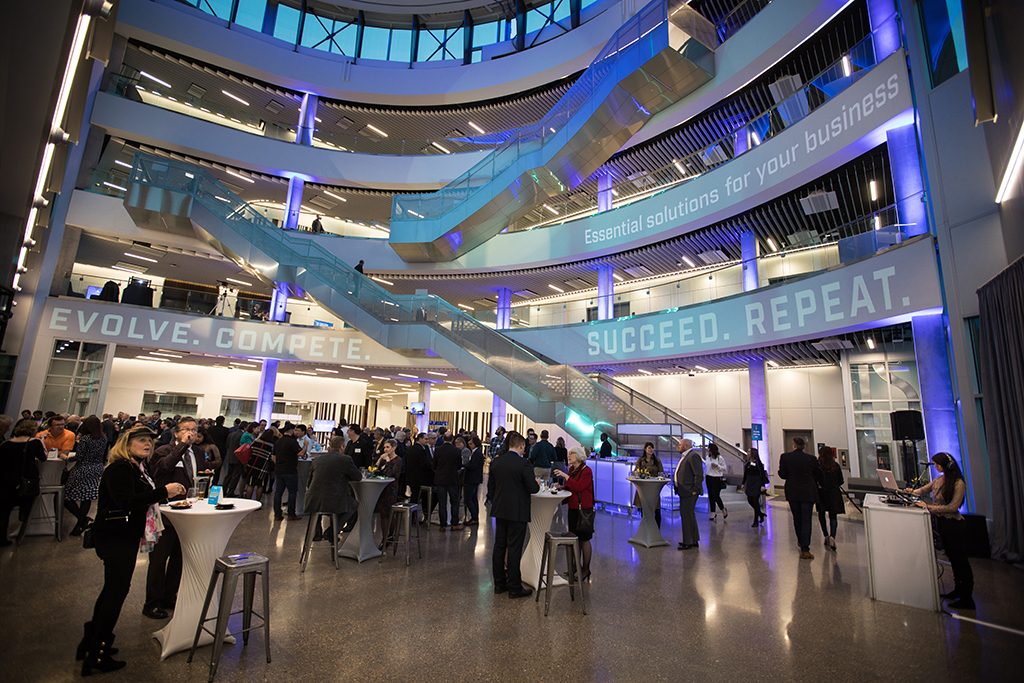EDMONTON – Edmonton’s biggest technical college is looking to industrialize and digitize construction through both physical spaces and networks of innovators.
The Northern Alberta Institute of Technology (NAIT) in Edmonton is leveraging its recently opened 190,00 sq. ft Productivity and Innovation Centre to house units such as a new Centre for Construction Innovation (CCI) dedicated to pushing the industry forward with new technologies.
NAIT director of research innovation Ryan Leskiw spoke to a British Columbia Construction Roundtable audience in Vancouver about the future of construction and the role NAIT hopes to play in giving industry a “digital playground” to test new ideas.
“The focus of this centre is working with the construction industry and post-secondary partners across Alberta, British Columbia and Saskatchewan to help drive productivity and environmental sustainability and over all performance of the construction industry in western Canada,” Leskiw said.
Leskiw also referred to the centre as a node in a “close to the network” strategy tying together various polytechnic schools, universities, research organizations and associations to further innovation. While NAIT already collaborates with other western Canadian schools on applied research, the network would strengthen and diversify collaboration efforts.
“This centre will be a first step towards a larger play,” he said. “What we’re looking for here is to try to form a broader and more formal network. Right now everyone’s been working together informally, but the creation of our centre will be the main focal point at NAIT to be a part of this network, but also help strengthen those ties between industry, post-secondaries as well as the public sector.”
Part of the initiative is a 20-acre full-scale test bed area in Spruce Grove just outside Edmonton for companies to prototype roads, buildings and other structures using real world conditions.
“Whatever you can bury, if you’re looking to test stuff underground. We want you to come play and see how you can test your processes before making changes in the field,” Leskiw said. “The idea is that it’s a true sandbox for industry partners looking to test something out, or even autonomous and other types of equipment for testing out before you use it on a job site.”
The centre already has smart building capabilities, sensor integration, industrial informatics and is capable of hosting large scale testing, Leskiw said, and is dedicated to interaction with industry rather than hosting academic programs in the building.
“[It’s about] looking at how a building is performing long-term, especially if you’re the owner. You’ve paid for the asset and you want to make sure it meets the criteria you have.” Leskiw said. “But also from a management perspective, if you can get into the realm of predictive maintenance by putting sensors on as many things as possible, you can use that data to monitor that building like a patient or when you take your car in for its regular check-up.”
While construction is focused on data analytics and “there are lots of processes that could be improved by asset tracking and digitizing,” in the next few years technologies like further wireless adoption, 5G networks, robots and the use of exosuits will transform the industry, Leskiw said.
“One of the projects we’re looking at is using exoskeletons with a couple of different trades in the Edmonton region, and the idea is to lessen the impact of repetitive tasks,” he said.
Exoskeletons can provide stability, make the worksite safer and prolong the lifespan where a worker can continue to do often physically demanding tasks, Leskiw said.
NAIT is looking to expand on its initial list of partners in the longer term, he added.
“We want ongoing sharing of ideas, looking at projects and problems and just sharing of expertise with NAIT and other partners as we expand throughout western Canada, just so we’re aware of what the trends and needs are in industry and that we can help address them,” Leskiw said.












Recent Comments